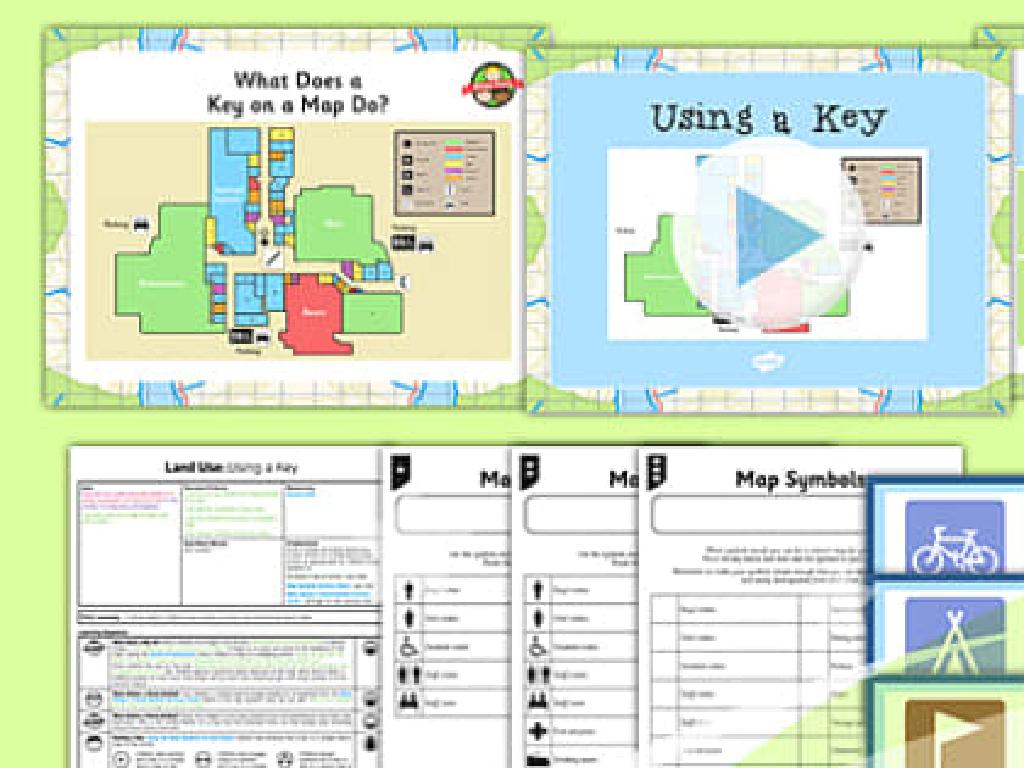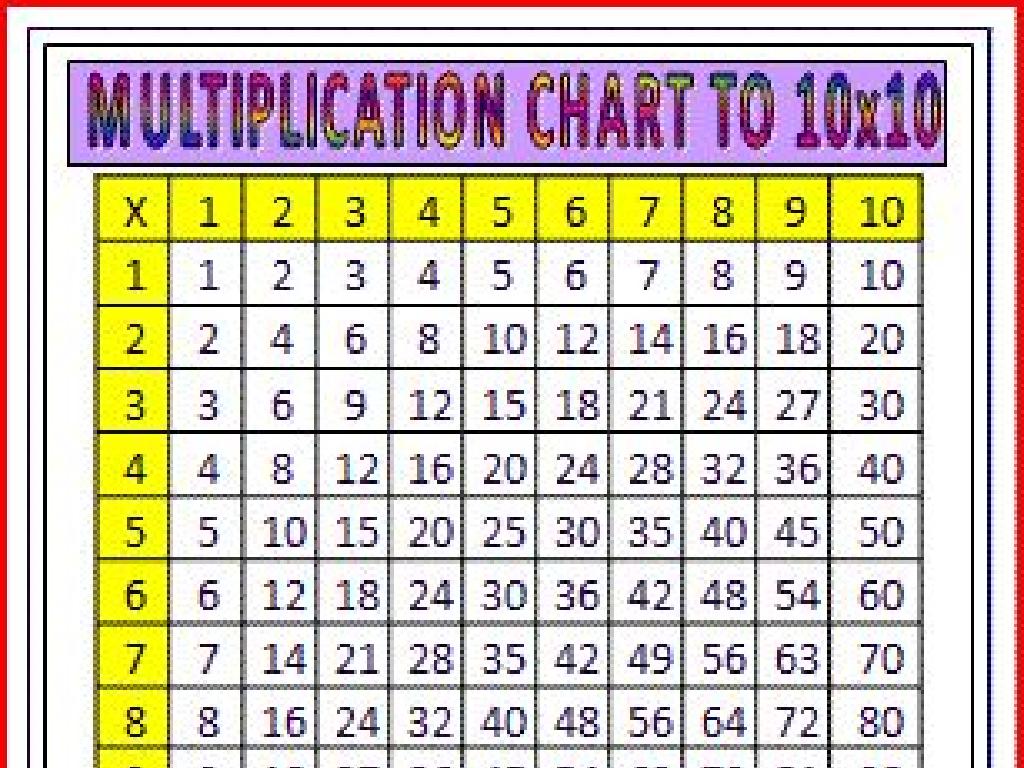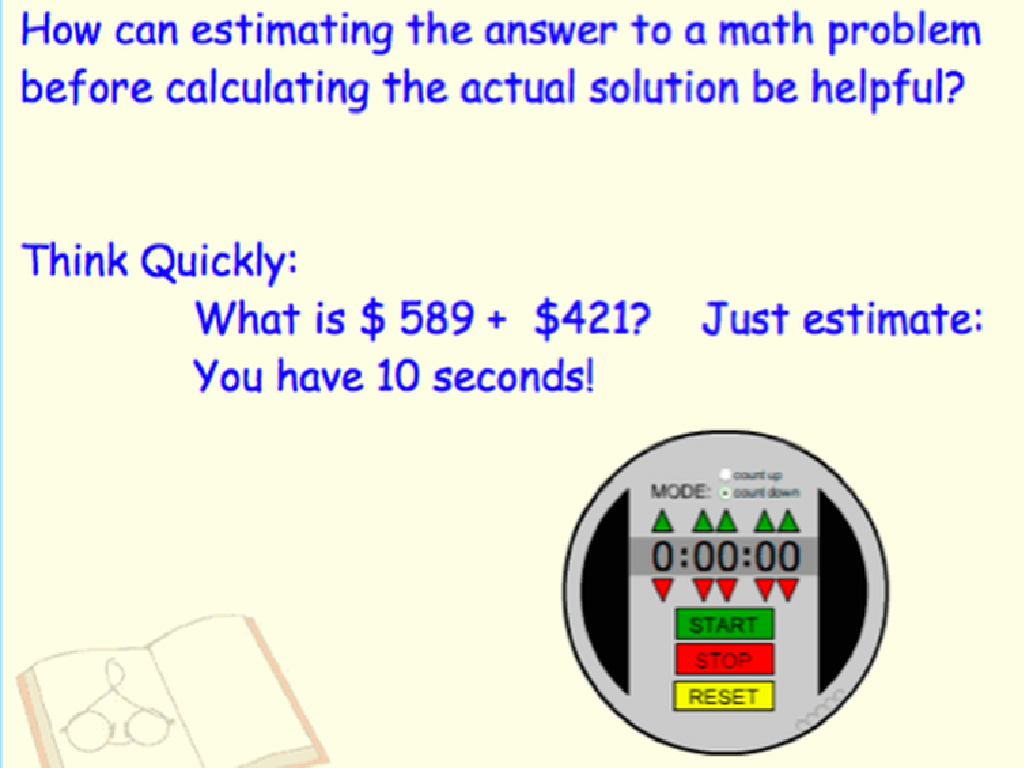Ratios And Rates: Word Problems
Subject: Math
Grade: Sixth grade
Topic: Ratios And Rates
Please LOG IN to download the presentation. Access is available to registered users only.
View More Content
Understanding Ratios and Rates
– Define ratios and rates
– A ratio compares two quantities, while a rate compares two different units.
– Daily applications of ratios
– Ratios help us cook or mix drinks correctly.
– Examples: Recipes and speed
– Ratios: 2 eggs per cake. Rates: 60 miles per hour.
– Solving real-world problems
|
This slide introduces students to the concepts of ratios and rates, setting the foundation for understanding how these mathematical tools are used in everyday life. Begin by defining a ratio as a comparison of two quantities and a rate as a comparison of two different units. Emphasize the practicality of these concepts by discussing how ratios are essential in cooking to get the ingredients right, or in mixing drinks. Provide real-life examples such as using ratios for recipes (e.g., 2 eggs for every cake) and rates for speed (e.g., traveling 60 miles in one hour). Encourage students to think of other examples where they encounter ratios and rates in their daily lives. The goal is to help students see the relevance of math in the real world and to prepare them for solving word problems that involve ratios and rates.
Understanding Ratios
– Define a ratio
– A ratio shows how much of one thing there is compared to another
– Ratio: A comparison of quantities
– Ratios tell us how two numbers or amounts are related
– Example: Fruit basket ratios
– If a basket has 2 apples for every 3 oranges, the ratio is 2:3
– Example: Classroom seating ratios
– A classroom has 15 desks for 30 students, the ratio of desks to students is 1:2
|
This slide introduces the concept of ratios, which are a fundamental part of understanding relationships between quantities. Start by defining a ratio as a way to compare two quantities, showing how much of one thing there is compared to another. Use tangible examples like fruit baskets and classroom seating to illustrate the concept. For instance, a fruit basket with a certain number of apples to oranges can be expressed as a ratio. Similarly, the ratio of desks to students in a classroom provides a practical example. Encourage students to think of ratios in terms of parts of a whole and to visualize the comparison. The goal is for students to be able to identify and write ratios from word problems and real-life situations.
Writing Ratios: Different Forms
– Ratios express comparison
– Three forms: fraction, colon, words
– Example: 1 to 2, 1:2, 1/2
– Compare apples to oranges: 3 apples, 6 oranges can be 3 to 6, 3:6, or 3/6
– Practice with classroom items
– Count and compare items like pencils to erasers
|
This slide introduces students to the concept of ratios and the different ways they can be written. Emphasize that ratios are a way to compare quantities and can be expressed in three forms: as fractions, using colons, or with words. Use everyday classroom objects to create relatable examples. For instance, if there are 3 pencils and 6 erasers, the ratio of pencils to erasers can be written as 3 to 6, 3:6, or 3/6. Encourage students to practice by identifying items in the classroom and writing their ratios in all three forms. This hands-on activity will help solidify their understanding of ratios and how they are used in various contexts.
Understanding Rates
– Define a rate
– A rate is a special ratio comparing two different units.
– Rate vs. ratio comparison
– Unlike ratios, rates compare related quantities with different units.
– Examples of rates
– Miles per hour (speed), price per item (cost).
– Application in real life
– How fast a car goes, or cost of fruits per pound.
|
A rate is a specific type of ratio that compares two quantities with different units, such as speed (miles per hour) or density (people per square mile). It’s important for students to understand the difference between a rate and a simple ratio, which compares quantities of the same unit. Provide real-life examples like the speed of a vehicle or the price of items to illustrate the concept. Encourage students to think of other examples of rates they encounter in daily life and to understand how rates help us make decisions and understand the world around us. For homework, they could find examples of rates in their environment or in the family shopping list.
Understanding Unit Rates
– Define a unit rate
– A unit rate compares a quantity to one unit of another quantity.
– How to find a unit rate
– Divide the total quantity by the number of units.
– Example: Cost per item
– If 5 apples cost $10, the unit rate is $2 per apple.
– Example: Words per minute
– Reading 120 words in 2 minutes means 60 words per minute.
|
This slide introduces the concept of unit rates, which is a comparison of any two quantities with different units. Start by defining a unit rate and explaining that it is a way to compare prices, speeds, or other measurements when one of the quantities is one. Show students how to calculate the unit rate by dividing the total amount by the number of units. Use everyday examples like the cost of apples or reading speed to make the concept relatable. Encourage students to think of other examples and to practice calculating unit rates from various word problems. This foundational skill will help them in understanding more complex ratio and rate problems.
Solving Ratio and Rate Word Problems
– Understand problem-solving steps
– Identify quantities and their units
– Find the numbers and what they describe, like ‘apples per basket’
– Apply ratio and rate reasoning
– Use ratios like ‘3:2’ to compare quantities
– Practice with examples
– For instance, if a recipe needs 3 cups of flour for 2 cups of sugar, how much sugar for 6 cups of flour?
|
This slide is aimed at guiding students through the process of solving word problems involving ratios and rates. Start by discussing the steps to approach these problems, emphasizing the importance of understanding the question before attempting to solve it. Next, focus on identifying the key quantities and their associated units, which is crucial for setting up the problem correctly. Teach students how to use ratio and rate reasoning, such as setting up proportions or using unit rates to find the answer. Provide practice examples and encourage students to explain their reasoning as they solve each problem. This will help solidify their understanding and prepare them for more complex problems.
Solving Word Problems Involving Ratios
– Carefully read the problem
– Figure out what to solve for
– Set up a ratio or rate
– Compare two quantities with a ratio
– Solve for the unit rate
– If 3 apples cost $1.50, what’s the cost per apple?
|
This slide is aimed at teaching students a systematic approach to solving word problems involving ratios and rates. Start by reading the problem thoroughly to understand what is being asked. Next, identify the specific question or quantity that needs to be found. Then, set up a ratio or rate based on the information given in the problem. For example, if 3 apples cost $1.50, the ratio of apples to cost is 3 to 1.50. To find the unit rate, which is the cost for one apple, divide $1.50 by 3. The answer is $0.50 per apple. Encourage students to practice this method with various problems to become proficient at identifying and solving for ratios and rates.
Ratios and Rates: Practice Problems
– Solve practice problems together
– Explain your problem-solving process
– Share why you chose a particular method
– Discuss various solution strategies
– There’s often more than one way to solve a problem
– Embrace different problem-solving methods
– Understanding others’ methods can offer new insights
|
This slide is designed to engage students in collaborative problem-solving, reinforcing their understanding of ratios and rates through practice problems. Encourage students to articulate their reasoning as they work through problems, fostering a deeper comprehension of the concepts. Emphasize that different approaches can be valid and that discussing these can enhance problem-solving skills. Provide guidance on how to approach word problems and encourage students to consider various strategies. In the next class, facilitate a discussion where students can share their methods and learn from each other, promoting an inclusive and supportive learning environment.
Class Activity: Ratio Scavenger Hunt
– Find classroom ratios
– Identify real-life rates
– E.g., Speed of a car: 60 miles per hour
– Share findings with class
– Explain your reasoning
– Discuss how you determined the ratios and rates
|
This interactive activity is designed to help students recognize and understand ratios and rates in their immediate environment and in everyday situations. Students will search the classroom for examples of ratios, such as the number of windows to doors, or the number of students to desks. They will also identify rates from scenarios provided by the teacher, such as the speed of a car or the cost of fruits per pound. After the scavenger hunt, students will share their findings with the class and explain the reasoning behind their identification of ratios and rates. For the teacher: Prepare a list of real-life scenarios with rates for students to analyze. Encourage students to think critically about where they see ratios and rates in their daily lives. Provide guidance on how to express their findings clearly and accurately.
Homework and Wrap-up: Ratios and Rates
– Review today’s key concepts
– Solve assigned word problems
– Complete problems on ratios and rates for homework
– Practice setting up ratios
– Use examples from class to set up your own ratios
– Practice solving rates
– Apply methods learned to calculate rates in different scenarios
|
As we wrap up today’s lesson on ratios and rates, it’s important for students to reinforce what they’ve learned by practicing with word problems. For homework, students should solve the assigned problems, ensuring they understand how to set up and solve ratios and rates in various contexts. Encourage them to refer back to their notes and the examples discussed in class. Remind them that practice is key to mastering these concepts. In the next class, we will review the homework answers and clarify any doubts, so students should come prepared with questions. This will help solidify their understanding and prepare them for more complex problems.





